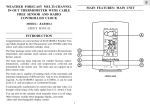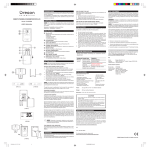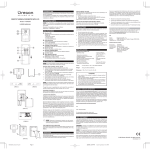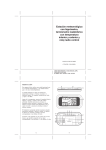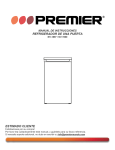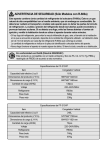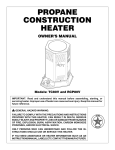Download REMOTE THERMO SENSOR WITH LCD MODEL
Transcript
EN INTRODUCTION REMOTE THERMO SENSOR WITH LCD MODEL: THR138 User Manual Congratulations on your purchase of the THR138 Remote Thermo Sensor. This Remote Thermo Sensor is for use with the 433 MHz Multi-Channel In-Out Thermometer to monitor temperature changes of outdoor sites. Operation is easy and no wire installation is required. COMPATIBLE UNITS D E F EMR812A BAR888A RMR112A A. LCD Displays the current temperature monitored by the remote unit B. LED INDICATOR Flashes when the remote unit transmits a reading C. ºC / ºF SLIDE SWITCH Selects between Centigrade (ºC) and Fahrenheit (ºF) D. CHANNEL SLIDE SWITCH Designates the remote unit Channel 1, Channel 2 or Channel 3 E. RESET BUTTON Returns all settings to default values F. BATTERY COMPARTMENT Accommodates two UM-3 AA size alkaline batteries G. BATTERY DOOR H. WALL-MOUNT HOLDER Supports the remote unit in wall-mounting I. REMOVABLE TABLE STAND For standing the remote unit on a flat surface To ensure proper reception between the main unit and the remote sensor, follow these instructions carefully. Battery and channel installation -3 1.5V • OPERATION • 1. Place both units as close as possible to each other. 2. Assign a different channel to each remote sensor by changing the channel switch in the battery compartment of the remote sensor. 3. Select the units of measurement for the temperature display on the ºC / ºF slide switch. 4. Install 2 alkaline batteries (UM-3 or “AA” size 1.5V) strictly according to the polarities shown. 5. Insert batteries or press the reset button of the main unit. Follow the instructions as set out in the user’s manual. 6. Position the remote sensor and main unit within effective transmission range, which in usual circumstances, is 98 feet (30 meters). NOTE The effective range may be limited by building materials and the position of either the main unit or remote sensors. Try various set-up arrangements for best result. CAUTION The content of this manual is subject to change without further notice. Due to printing limitations, the displays shown in this manual may differ from the actual display. The manufacturer and its suppliers hold no responsibility to you or any other person for any damage expenses, lost profits, or any other claim as a result of using this product. The contents of this manual may not be reproduced without the permission of the manufacturer. ABOUT OREGON SCIENTIFIC The reset function is required only when the unit is operating in an unfavorable way or malfunctioning. To access: 1. Lift open the battery compartment door. 2. Place a blunt stylus into the hole marked RESET and press. 3. Replace the battery compartment door. See the user’s manual of your main unit for further information. HOW TO USE THE TABLE STAND OR WALL MOUNT This sensor comes with a wall-mount holder and a removable stand. Use either to hold the unit in place. (FIG A) PRECAUTIONS This product is engineered to give you years of satisfactory service if you handle it carefully. Here are a few precautions. 1. Do not immerse the unit in water. 2. Do not clean the unit with abrasive or corrosive materials. They may scratch the plastic parts and corrode the electronic circuit. 3. Do not subject the unit to excessive force, shock, dust, temperature or humidity. Which may result in malfunction, shorter electronic life span, damaged battery and distorted parts. 4. Do not tamper with the unit’s internal components. Doing so will invalidate the warranty on the unit and may cause unnecessary damage. The unit contains no userserviceable parts. 5. Only use fresh batteries as specified in the user’s manual. Do not mix old and new batteries. Do not mix alkaline, standard (carbon-zinc), or rechargeable (nickelcadmium) batteries. 6. Always read the user’s manual thoroughly before operating the unit. TROUBLESHOOTING PROBLEM SYMPTOM Remote sensor Cannot locate remote sensor Cannot change channel Data does not match main unit REMEDY Check batteries Check location Check all sensors for proper operation Initiate a manual sensor search SPECIFICATIONS Standard Alkaline batteries contain signifcant amounts of water. Because of this they will freeze in low temperatures of approximately 10ºF (-12ºC). Disposable Lithium batteries have a much lower threshold for temperature with an estimated freezing range of below -40ºF (-40ºC). The Liquid Crystal Display in outdoor thermometers will remain operational to -20ºF (-29ºC) with adequate power. Wireless ranges can be impacted by a variety of factors such as extremely cold temperatures. Extreme cold may temporarily reduce the effective range between the sensor and the base station. If the unit’s performance fails due to low temperature, the unit will resume proper functioning as the temperature rises to within the normal temperature range (i.e no permanent damage will occur to the unit due to low temperatures). CHANGING CHANNELS Temperature Measurement Displayed range : Proposed operating range : Temperature resolution : RF transmission frequency : No. of remote unit : RF transmission range : Temperature sensing cycle : Power : Weight : Dimension : Visit our website (www.oregonscientific.com) to learn more about Oregon Scientific products such as digital cameras; MP3 players; children’s electronic learning products and games; projection clocks; health and fitness gear; weather stations; and digital and conference phones. The website also includes contact information for our Customer Care department in case you need to reach us, as well as frequently asked questions and customer downloads. We hope you will find all the information you need on our website, however if you’re in the US and would like to contact the Oregon Scientific Customer Care department directly, please visit: www2.oregonscientific.com/service/default.asp OR Call 1-800-853-8883. For international inquiries, please visit: www2.oregonscientific.com/about/international.asp FCC STATEMENT This device complies with Part 15 of the FCC Rules. Operation is subject to the following two conditions: (1) This device may not cause harmful interference, and (2) This device must accept any interference received, including interference that may cause undesired operation. WARNING Changes or modifications not expressly approved by the party responsible for compliance could void the user's authority to operate the equipment. NOTE This equipment has been tested and found to comply with the limits for a Class B digital device, pursuant to Part 15 of the FCC Rules. These limits are designed to provide reasonable protection against harmful interference in a residential installation. This equipment generates, uses and can radiate radio frequency energy and, if not installed and used in accordance with the instructions, may cause harmful interference to radio communications. However, there is no guarantee that interference will not occur in a particular installation. If this equipment does cause harmful interference to radio or television reception, which can be determined by turning the equipment off and on, the user is encouraged to try to correct the interference by one or more of the following measures: • • • -50.0ºC to + 70.0ºC (-58.0ºF to 158.0ºF) -22.0ºF to +140.0ºF (-30.0ºC to +60.0ºC) 0.1ºC (0.2ºF) 433 MHz maximum of 3 maximum of 98 ft (30 m) around 30 seconds use 2pcs UM-3 “AA” 1.5V alkaline batteries 3 oz (83 g) (without batteries) 4 x 2.8 x 0.9 in (105 x 70 x 22.5 mm) (H x W x D) Once a channel is assigned to a unit, you can only change it by removing the batteries and repeating the above procedure. [ FIG A ] 2 • The remote sensor reading shown on the LCD depends on which remote sensor channel has been chosen. Though the sensor is weatherproof, and is meant for use outside, it should be placed away from direct sunlight, rain, or snow. THR138R_EN-SP_op05122.p65 • Once batteries are in place, the sensor will start transmitting samplings at 30-second intervals. HOW TO RESET THE UNIT • • • BEFORE YOU BEGIN AA / UM-3 1.5V AA Replace the batteries of the sensor when the low-battery indicator of the channel represented by the sensor lights up on the main unit. Examples of compatible units are as follows: MAIN FEATURES C declare that the product LOW-BATTERY WARNING 12/22/05, 5:33 PM • Reorient or relocate the receiving antenna. Increase the separation between the equipment and receiver. Connect the equipment into an outlet on a circuit different from that to which the receiver is connected. Consult the dealer or an experienced radio / TV technician for help. DECLARATION OF CONFORMITY The following information is not to be used as contact for support or sales. Please call our customer service number (listed on our website at www.oregonscientific.com), or on the warranty card for this product) for all inquiries instead. We Name: Address: Telephone No.: Oregon Scientific, Inc. 19861 SW 95th Ave., Tualatin, Oregon 97062 USA 1-800-853-8883 Product No.: Product Name: Manufacturer: Address: THR138 Remote Sensor IDT Technology Limited Block C, 9/F, Kaiser Estate, Phase 1,41 Man Yue St., Hung Hom, Kowloon, Hong Kong is in conformity with Part 15 of the FCC Rules. Operation is subject to the following two conditions: 1) This device may not cause harmful interference. 2) This device must accept any interference received, including interference that may cause undesired operation. © 2006 Oregon Scientific. All rights reserved. valor normal (es decir, la unidad no sufrirá daños permanentes por las bajas temperaturas). ES SENSOR TERMICO REMOTO CON PANTALLA LCD MODELO: THR138 Manual del usuario INTRODUCCION CAMBIO DE CANALES Felicitaciones por la compra del Sensor térmico remoto THR138. Este sensor térmico remoto se utiliza con el Termómetro de interior y exterior de varios canales de 433 Mhz que sirve para controlar los cambios de temperatura en el exterior. La operación es fácil y su instalación no requiere cables. Una vez asignado un canal a una unidad, únicamente podrá cambiarlo extrayendo las baterías y repitiendo el procedimiento anterior. UNIDADES COMPATIBLES Estos son ejemplos de unidades compatibles: • • • EMR812A BAR888A RMR112A CARACTERISTICAS PRINCIPALES D C E F A. PANTALLA LCD Muestra la temperatura actual controlada por la unidad remota. B. INDICADOR LED Parpadea cuando la unidad remota transmite una lectura. C. INTERRUPTOR DESLIZABLE ºC / ºF Selecciona entre grado Centígrado (°C) y Fahrenheit (°F) D. INTERRUPTOR DESLIZABLE DE CANALES Selecciona entre el Canal 1, Canal 2 o Canal 3 de la unidad remota. E. BOTON RESTABLECER Vuelve todos los parámetros a los valores predeterminados. F. COMPARTIMIENTO DE BATERIAS Para dos baterías alcalinas UM-3 AA. G. PUERTA DEL COMPARTIMIENTO DE BATERIAS H. SOPORTE DE MONTAJE EN LA PARED Sirve para fijar la unidad remota en la pared. I. SOPORTE DESMONTABLE PARA MESA Sirve para apoyar la unidad remota sobre una superficie plana. ADVERTENCIA DE BATERIA BAJA Reemplace las baterías del sensor cuando el indicador de batería baja del canal de dicho sensor se encienda en la unidad principal. OPERACION Una vez colocadas las baterías, el sensor comenzará a transmitir muestras a intervalos de 30 segundos. Instalación de la batería y del canal 1. Coloque ambas unidades lo más cerca posible entre sí. 2. Asigne un canal diferente a cada sensor remoto seleccionándolo con el interruptor de canales ubicado en el compartimiento de baterías del sensor remoto. 3. En el interruptor deslizable ºC/ºF, seleccione la unidad de medida para la visualización de la temperatura. 4. Instale 2 baterías alcalinas (UM-3 o “AA” de 1.5 V) siguiendo estrictamente la indicación de polaridad. 5. Inserte las baterías o presione el botón Restablecer de la unidad principal. Siga las instrucciones estipuladas en el manual del usuario. 6. Ubique el sensor remoto y la unidad principal dentro del alcance de transmisión efectiva; en circunstancias normales, es de 30 metros (98 pies). AA / UM-3 1.5V AA -3 1.5V Para garantizar una recepción correcta entre la unidad principal y el sensor remoto, siga con detenimiento estas instrucciones. NOTA Observe que los materiales de construcción y la posición de la unidad principal o de los sensores remotos afectan el alcance efectivo de transmisión. Pruebe varias disposiciones de instalación para obtener mejores resultados. Si bien el sensor es resistente a la intemperie y está diseñado para ser utilizado en el exterior, no se debe colocar en lugares expuestos a la luz solar directa, la lluvia o la nieve. Las baterías alcalinas estándar contienen grandes cantidades de agua. Por este motivo, puede ocurrir que se congelen en lugares de baja temperatura, aproximadamente 12° C (-10° F). Las baterías de litio desechables tienen un umbral mucho más bajo respecto a la temperatura, se estima que se congelarán a temperaturas menores de -40° C (-40° F). La pantalla de cristal líquido de los termómetros para exterior seguirá funcionando a -29° C (-20° F) siempre que la unidad tenga la energía adecuada. El alcance del sistema inalámbrico se puede ver afectado por una variedad de factores como las temperaturas extremadamente frías. El frío extremo puede reducir temporalmente el alcance efectivo entre el sensor y la estación base. Si el rendimiento de la unidad falla debido a una temperatura baja, la unidad volverá a funcionar correctamente cuando la temperatura suba y alcance un [ FIG A ] THR138R_EN-SP_op05122.p65 3 Energía: • COMO RESTABLECER LA UNIDAD • PRECAUCION La función restablecer es necesaria únicamente cuando la unidad funciona mal o en forma incorrecta. • Para tener acceso: 1. Levante la puerta del compartimiento de batería. 2. Coloque un punzón romo en el orificio donde dice RESTABLECER y presione. 3. Vuelva a colocar la puerta del compartimiento. • Para obtener más información, consulte el manual del usuario de la unidad. COMO USAR EL SOPORTE PARA MESA O PARA EL MONTAJE EN LA PARED Este sensor viene con un soporte para montaje en la pared y un soporte desmontable para la mesa. Use cualquiera de los dos para colocar la unidad en el lugar que desee. (FIG. A) Si el producto se manipula con el debido cuidado, le proporcionará años de servicio satisfactorio. A continuación se describen algunas precauciones. 1. No sumerja la unidad en agua. 2. No limpie la unidad con materiales abrasivos o corrosivos. Puede rayar las piezas de plástico y corroer el circuito electrónico. 3. No someta la unidad a fuerzas extremas, golpes, polvo, temperatura o humedad. Tales condiciones pueden ocasionar mal funcionamiento, menor vida útil respecto al sistema electrónico, daños en las baterías o piezas deformadas. 4. No golpee los componentes internos de la unidad. Si lo hace, puede dañar la unidad y la garantía quedará anulada. La unidad no contiene piezas que el usuario pueda reparar. 5. Utilice únicamente baterías nuevas según las especificaciones del manual de instrucciones. No mezcle pilas nuevas con usadas. No mezcle pilas alcalinas, estándar (carbón-cinc), o recargables (níquel-cadmio). 6. Antes de operar la unidad, lea este manual de instrucciones detenidamente. SOLUCION DE PROBLEMAS Verifique aquí antes de comunicarse con nuestro departamento de atención al cliente (consulte la sección Acerca de Oregon Scientific para obtener detalles de contacto). PROBLEMA SINTOMA Sensor remoto No se puede ubicar el sensor remoto No se puede cambiar el canal SOLUCIÓN Verifique las baterías Verifique la ubicación Examine todos los sensores para un funcionamiento adecuado Los datos no Inicie una búsqueda coinciden con la manual de sensores unidad principal ESPECIFICACIONES Medición de la temperatura Intervalo que se muestra -50º C a +70º C en pantalla: (-58º F a 158º F) 12/22/05, 5:33 PM Use 2 baterías alcalinas UM-3 “AA” de 1.5 V 83 g (3 onzas) (sin baterías) 105 x 70 x 22.5 mm (4 x 2.8 x 0.9 pulg.) (H x A x Prof.) Peso: Dimensiones: La lectura del sensor remoto que aparece en la pantalla LCD depende del canal de sensor remoto que se haya elegido. PRECAUCIONES ANTES DE COMENZAR Intervalo de operación -30º C a +60º C propuesto: (-22º F a +140º F) Resolución de temperatura: 0.1º C (0.2º F) Frecuencia de transmisión de RF: 433 MHz Cantidad de unidades remotas: 3 como máximo Alcance de transmisión de RF: 30 m (98 pies) como máximo Ciclo del sensor de temperatura: 30 segundos aproximadamente El contenido de este manual está sujeto a cambios sin previo aviso. Debido a limitaciones de impresión, las pantallas que se muestran en este manual pueden diferir de la pantalla real. El fabricante y sus distribuidores no serán responsables ante usted o ante otras personas por los gastos a causa de daños, por las ganancias perdidas o por otros reclamos originados de la utilización de este producto. Está prohibida la reproducción del contenido de este manual sin el consentimiento del fabricante. • • • • Vuelva a orientar o a ubicar la antena receptora. Incremente la distancia entre el equipo y el receptor. Conecte el equipo a un tomacorriente en un circuito distinto del que utilizó para conectar el receptor. Consulte al distribuidor o a un técnico experto en radio/ TV para obtener ayuda. DECLARACION DE CONFORMIDAD La siguiente información no se utilizará como contacto para soporte técnico o ventas. Para realizar todas sus consultas, llame a nuestro número de atención al cliente (mencionado en nuestro sitio web en www.oregonscientific.com o en la tarjeta de garantía de este producto). Nosotros Nombre: Dirección: Número de teléfono: Oregon Scientific, Inc. 19861 SW 95th Ave., Tualatin, Oregon 97062 Estados Unidos 1-800-853-8883 declaramos que el producto Número de producto: Nombre del producto: Fabricante: Dirección: THR138 Sensor remoto IDT Technology Limited Block C, 9/F, Kaiser Estate, Phase 1,41 Man Yue St., Hung Hom, Kowloon, Hong Kong cumple con la Parte 15 de las Reglas de la FCC. Su funcionamiento queda sujeto a las dos condiciones siguientes: (1) Es probable que este dispositivo no provoque interferencias perjudiciales. (2) Este dispositivo debe aceptar las interferencias que reciba, incluso las interferencias que puedan provocar un funcionamiento no deseado. ACERCA DE OREGON SCIENTIFIC Visite nuestro sitio web (www.oregonscientific.com) para obtener más información sobre los productos de Oregon Scientific, por ejemplo, cámaras digitales, reproductores MP3, productos y juegos de aprendizaje electrónicos para niños; relojes de proyección; equipos para la salud y de gimnasia; estaciones meteorológicas, teléfonos digitales y de conferencia. El sitio web también incluye información de contacto de nuestro departamento de atención al cliente en caso de que necesite comunicarse con nosotros, además de preguntas frecuentes y descargas para clientes. Esperamos que en nuestro sitio web encuentre toda la información que necesite, no obstante, si es residente de Estados Unidos y desea comunicarse directamente con el departamento de Atención del cliente de Oregon Scientific, visite: www2.oregonscientific.com/service/default.asp O Llame al 1-800-853-8883. Para consultas internacionales, visite: www2.oregonscientific.com/about/international.asp DECLARACION DE LA COMISION FEDERAL DE COMUNICACIONES (FCC) Este dispositivo cumple con la Parte 15 de las Reglas de la FCC (Comisión de Comunicaciones Federales). El funcionamiento de la unidad queda sujeto a las dos condiciones siguientes: (1) Es probable que este dispositivo no provoque interferencias perjudiciales y (2) Este dispositivo debe aceptar las interferencias que reciba, incluso las interferencias que puedan provocar un funcionamiento no deseado. ADVERTENCIA Los cambios o las modificaciones no aprobados en forma expresa por los responsables del cumplimiento de las normas pertinentes anulará la autoridad del usuario a operar el equipo. NOTA Este equipo ha sido probado y se comprobó que cumple con los límites estipulados para un dispositivo digital Clase B conforme a la Parte 15 de las Reglas de la FCC. Estos límites están diseñados para proporcionar protección razonable contra interferencias perjudiciales en una instalación residencial. Este equipo genera, usa y puede irradiar energía de radiofrecuencia y, si no se instala y utiliza de acuerdo a las instrucciones, puede provocar interferencias perjudiciales en las comunicaciones de radio. No obstante, no se garantiza que no se producirán interferencias en una instalación en particular. Si este equipo provoca interferencias perjudiciales en la recepción de radio o televisión, lo que puede determinarse al encender o apagar el equipo, se recomienda que el usuario intente corregirlas aplicando las siguientes medidas: © 2006 Oregon Scientific. Todos los derechos reservados. 086L001911-194


